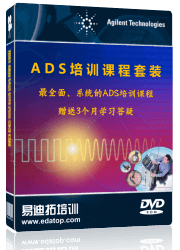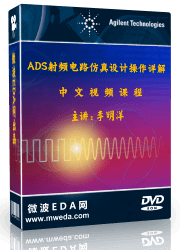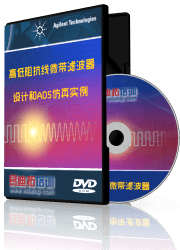- 易迪拓培训,专注于微波、射频、天线设计工程师的培养
How to plot constant Q curves on the ADS datadisplay smith chart
Do anybody know how to plot the constant Q curves on the ADS keysight datadisplay? (I want to use them for matching) (I found that on the Smith chart utility tool, there is an option to play them, but I want to plot them on the data display, I mean, when I simulate "real-non ideal from a given technology design kit"
Thank you,
Do you mean locuses of Q=X/R or Q=B/G on smith chart ?
Yes, I mean locuses of Q = X/R ( Q isn't the same value for both X/R for circuit in serie or B/G for circuit in parallel ?! and, isnt the same for both Z chart or Y chart or ZY chart?)
Thank you,
No.
Gamma=(Z/Z0-1)/(Z/Z0+1)=-(Y/Y0-1)/(Y/Y0+1)
Yes, of course there is a shift of 180 degree between Gamma calaculated according to Z and that calculated with Y, I didn't say the opposite.
But, the locus of constante Q in the Z, Y, and ZY chat is the same, for example, for Q=1, the locus ploted in the Z, Y and ZY chart is the same.
Anyways, how to plot the constant Q circle in the Z chart
Thanks,
Draw partial circle based on definition.
Center is (0, +1/Q) or (0, -1/Q).
Radius is sqrt(1+1/Q^2).
I don't know how to access to the resistance and reactance of the smith chart on the ADS datadisplay to plot the Q
And, I don't know how to plot the equation of a circle on ADS datadisplay
I want to notice that is not as simple as we could think, I searched but didnt find, this is why I am asking here
Thanks
we ?
Only you.
It's very easy and simple.
I'm also interested. Please tell us about the simple method how to draw these circles in ADS data display.
There is one solution on the attached document,
If needed, create custom AEL function.
Actually I have custom Skill function "Constat_Q_Circle(Q)" which returns Gamma for Q in Cadence dfII.
It's too unefficient since S is bilnear transformation of z, S=(z-1)/(z+1).
I think a following is good than Smith chart utility tool of ADS.
http://www.fritz.dellsperger.net/smith.html
Update....
Qserie=X/R=Qparallel=B/G => So, it results on the same
It is simple to demonstrate by taking a serie R-L circuit and calulate the parallel equivalent R-L...
"Constant_Q_Circle.ael"
defun Constant_Q_Circle(Q)
{
decl radius, S0p, th1, th2, dth, thp, nlen, Sp, Sm, Sq;
radius = sqrt( 1 + 1/(Q*Q) );
S0p = -j * (1/Q);
th1 = acos(1 / radius);
th2 = pi - th1;
dth = (th2 - th1) / 50;
thp = [th1::dth::th2];
nlen = sweep_size(thp);
Sp = S0p + radius * exp(j*thp);
Sp[0] = 1.0;
Sp[nlen-1] = -1.0;
Sm = conj(Sp);
Sq = [ Sp, Sm[nlen-2::-1::0] ];
return Sq;
}
申明:网友回复良莠不齐,仅供参考。如需专业帮助,请学习易迪拓培训专家讲授的ADS视频培训课程。
ADS中文视频培训教程 | More...
 国内最全面、最专业的Agilent ADS培训课程,可以帮助您从零开始,全面系统学习ADS设计应用【More..】
国内最全面、最专业的Agilent ADS培训课程,可以帮助您从零开始,全面系统学习ADS设计应用【More..】
- Agilent ADS教学培训课程套装
- 两周学会ADS2011、ADS2013视频教程
- ADS2012、ADS2013射频电路设计详解
- ADS高低阻抗线微带滤波器设计培训教程
- ADS混频器仿真分析实例视频培训课程
- ADS Momentum电磁仿真设计视频课程
- ADS射频电路与通信系统设计高级培训
- ADS Layout和电磁仿真设计培训视频
- ADS Workspace and Simulators Training Course
- ADS Circuit Simulation Training Course
- ADS Layout and EM Simulation Training Course
- Agilent ADS 内部原版培训教材合集









 沪公网安备 31011202014168号
沪公网安备 31011202014168号
 1427313829
1427313829 旺旺在线
旺旺在线 Skype Online
Skype Online 13761612886
13761612886 官方淘宝店
官方淘宝店
